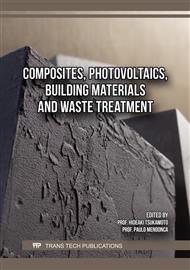[1]
A. J. Greer, J. Jacquemin, and C. Hardacre, Industrial applications of ionic liquids, Molecules, 25 (2020) 5207.
DOI: 10.3390/molecules25215207
Google Scholar
[2]
S. K. Singh and A. W. Savoy, Ionic liquids synthesis and applications: An overview, Journal of Molecular Liquids, 297 (2020) 112038.
DOI: 10.1016/j.molliq.2019.112038
Google Scholar
[3]
T. El Achkar, H. Greige-Gerges, and S. Fourmentin, Basics and properties of deep eutectic solvents: a review, Environmental chemistry letters, 19 (2021) 3397-3408.
DOI: 10.1007/s10311-021-01225-8
Google Scholar
[4]
B. B. Hansen et al., Deep eutectic solvents: A review of fundamentals and applications, Chemical reviews, 121 (2020) 1232-1285.
Google Scholar
[5]
J. Cai, J. Xue, Y. Li, L. Wei, N. Lin, and X. Zha, Research progress on high-value-added application of lignocellulosic biomass based on deep eutectic solvent pretreatment, Biomass Conversion and Biorefinery, 12 (2023) 1-16.
DOI: 10.1007/s13399-023-04972-6
Google Scholar
[6]
A. Mannu, M. Blangetti, S. Baldino, and C. Prandi, Promising technological and industrial applications of deep eutectic systems, Materials, 14 (2021) 2494 .
DOI: 10.3390/ma14102494
Google Scholar
[7]
A. Mišan et al., The perspectives of natural deep eutectic solvents in agri-food sector, Critical reviews in food science and nutrition, 60 (2020) 2564-2592.
DOI: 10.1080/10408398.2019.1650717
Google Scholar
[8]
M. H. Rasool and M. Ahmad, Synthesis and physico-chemical characterization of novel Epsom salt based natural deep eutectic solvent, Chemical Data Collections, 44 (2023) 101004.
DOI: 10.1016/j.cdc.2023.101004
Google Scholar
[9]
M. Rasool, M. Ahmad, and S. Hashmi, A novel potassium chloride based natural deep eutectic solvent: in-house synthesis and characterization, Moroccan Journal of Chemistry, 11 (2023) 871-883.
Google Scholar
[10]
M. H. Rasool, M. Ahmad, M. Ayoub, A. Zamir, and M. A. Abbas, A review of the usage of deep eutectic solvents as shale inhibitors in drilling mud, Journal of Molecular Liquids, 361 (2022) 119673.
DOI: 10.1016/j.molliq.2022.119673
Google Scholar
[11]
J. C. Deutsch, Ascorbic acid and dehydroascorbic acid interconversion without net oxidation or reduction, Analytical biochemistry, 247 (1997) 58-62.
DOI: 10.1006/abio.1997.2035
Google Scholar
[12]
J. Pantwalawalkar, H. More, D. Bhange, U. Patil, and N. Jadhav, Novel curcumin ascorbic acid cocrystal for improved solubility, Journal of Drug Delivery Science and Technology, 61 (2021) 102233.
DOI: 10.1016/j.jddst.2020.102233
Google Scholar
[13]
N. P. E. Hikmawanti, D. Ramadon, I. Jantan, and A. Mun'im, Natural deep eutectic solvents (NADES): Phytochemical extraction performance enhancer for pharmaceutical and nutraceutical product development, Plants, 10 (2021) 2091.
DOI: 10.3390/plants10102091
Google Scholar
[14]
A. R. Jesus, A. Paiva, and A. R. C. Duarte, Current developments and future perspectives on biotechnology applications of natural deep eutectic systems, Current Opinion in Green and Sustainable Chemistry, 39 (2023) 100731.
DOI: 10.1016/j.cogsc.2022.100731
Google Scholar
[15]
C. S. Lucea et al., Kinetic study of natural deep eutectic solvents by digital images: The importance of preparation time in sensing applications, Journal of Molecular Liquids, 386 (2023) 122514.
DOI: 10.1016/j.molliq.2023.122514
Google Scholar
[16]
X. Fang et al., Insights on the potential of natural deep eutectic solvents (NADES) to fine-tune durian seed gum for use as edible food coating, Food Hydrocolloids, 132 (2022) 107861.
DOI: 10.1016/j.foodhyd.2022.107861
Google Scholar
[17]
P. Dehury, U. Mahanta, and T. Banerjee, Comprehensive Assessment on the Use of Boron Nitride-Based Nanofluids Comprising Eutectic Mixtures of Diphenyl Ether and Menthol for Enhanced Thermal Media, ACS Sustainable Chemistry & Engineering, 8 (2020) 14595-14604.
DOI: 10.1021/acssuschemeng.0c05648
Google Scholar
[18]
Z. Yang, Natural deep eutectic solvents and their applications in biotechnology, Application of ionic liquids in biotechnology, 45 (2019) 31-59.
DOI: 10.1007/10_2018_67
Google Scholar
[19]
J. Boiteux et al., NADES blend for bioactive coating design as a sustainable strategy for postharvest control, Food Chemistry, 406 (2023) 135054.
DOI: 10.1016/j.foodchem.2022.135054
Google Scholar
[20]
V. Gupta, R. Thakur, and A. B. Das, Effect of natural deep eutectic solvents on thermal stability, syneresis, and viscoelastic properties of high amylose starch, International Journal of Biological Macromolecules, 187 (2021) 575-583.
DOI: 10.1016/j.ijbiomac.2021.07.099
Google Scholar
[21]
S. N. Rashid et al., A kinetic study of ex-situ soil remediation by nickel extraction using natural deep eutectic solvent, Environmental Technology, 33 (2023) 1-14.
DOI: 10.1080/09593330.2023.2283093
Google Scholar
[22]
N. M. Morgana, E. Magdalena, M. de los Angeles Fernandez, and S. M. Fernanda, NADES for food industry innovation: Novel bioadditives based on olive oil byproducts, Food and Bioproducts Processing, 134 (2022) 193-201.
DOI: 10.1016/j.fbp.2022.05.007
Google Scholar
[23]
F. J. V. Gomez, M. Espino, M. de los Angeles Fernandez, J. Raba, and M. F. Silva, Enhanced electrochemical detection of quercetin by natural deep eutectic solvents, Analytica Chimica Acta, 936 (2016) 91-96.
DOI: 10.1016/j.aca.2016.07.022
Google Scholar
[24]
C. Cecone et al., Sustainable synthesis of cyclodextrin-based polymers by exploiting natural deep eutectic solvents, Green chemistry, 22 (2020) 5806-5814.
DOI: 10.1039/d0gc02247k
Google Scholar
[25]
M. H. Rasool, M. Ahmad, N. A. Siddiqui, and A. Z. Junejo, Eco-friendly drilling fluid: calcium chloride-based natural deep eutectic solvent (NADES) as an all-rounder additive, Energies, 16 (2023) 5533.
DOI: 10.3390/en16145533
Google Scholar


